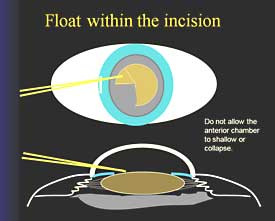CCC technique preferred method for cataract surgery
Keep the anterior chamber well-formed and the anterior lens capsule flattened during creation of continuous curvilinear capsulorrhexis.
Click Here to Manage Email Alerts
 Decades ago, the method for cataract surgery was intracapsular extraction, where the entire cataract and its capsule were removed from the eye. This has changed, and now more than 99% of the time, we remove just the cataractous material while leaving the capsule and zonular structures intact, hence the name extracapsular extraction.
Decades ago, the method for cataract surgery was intracapsular extraction, where the entire cataract and its capsule were removed from the eye. This has changed, and now more than 99% of the time, we remove just the cataractous material while leaving the capsule and zonular structures intact, hence the name extracapsular extraction.
We started with using a needle to make multiple punctures in the anterior lens capsule to create an opening and access the cataract nucleus. Although this works, it makes for a less stable capsular bag and carries higher complication rates. Instead, our preferred method is creation of the continuous curvilinear capsulorrhexis.
 Uday Devgan |
For most cases, our ideal capsulorrhexis is a well-centered, round opening of the anterior capsule with a diameter of about 5 mm. This allows sufficient access to the nuclear material, and at the end of the case it allows secure placement of a standard posterior chamber IOL within the capsular bag. The typical IOL has a diameter of 6 mm, and our 5-mm capsulorrhexis is therefore able to cover the edge of the optic and hold it securely in position after surgery.
It is important to keep the anterior chamber well-formed and the anterior lens capsule flattened during our capsulorrhexis creation. This prevents run-off and radicalization of the capsulorrhexis and allows for more control. The two keys to achieving this stable anterior chamber and flat capsule are using a good cohesive viscoelastic and float within the incision. This prevents collapse of the anterior chamber. You will remember from previous columns the importance of floating within the incision, not distorting the eye, and pivoting the instruments.
|
Images: Devgan U |
Step 1
To start the capsulorrhexis, a single puncture is made in the central part of the anterior lens capsule. This can be done using a bent needle, called a cystotome, or by using the tips of the capsulorrhexis forceps. My capsulorrhexis forceps are marked with two lines, one at 2.5 mm and a second at 5 mm, to facilitate creation of a capsulorrhexis with an exact 5-mm diameter each time. When the sharp tips of the forceps are poked into the center of the anterior lens capsule, the 2.5-mm-mark represents the radius of our intended capsulorrhexis.
Step 2
To propagate the tearing of the capsulorrhexis, it is important to keep the torn capsule folded over, as this allows the tear to proceed in a more controlled manner. I recommend understanding the force vectors required for capsulorhexis creation by practicing using your fingers to tear large 10-cm circles in newspaper. This will highlight the importance of keeping the torn capsule folded over.
Step 3
As we proceed to tear the circular capsulorrhexis, we will notice that halfway through the rhexis, the 2.5-mm hash mark of the forceps tip should be in the exact center, and the 5-mm hash mark should be at the outer edge of the capsulorrhexis. This ensures that we are tearing the proper size capsulorrhexis.
Step 4
We complete the capsulorrhexis using the same technique, and the torn central remnant is removed from the eye and discarded. If the capsule radializes, it is important to stop, inject more cohesive viscoelastic, and try to bring it centrally once again. If it extends too far radial and out to the zonules, you may not be able to retrieve it, and in this case you can finish by going in the opposite direction with the capsulorrhexis or by using the bent needle cystotome to place a series of punctures in the intended areas.
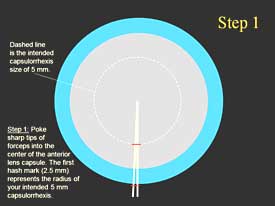 | 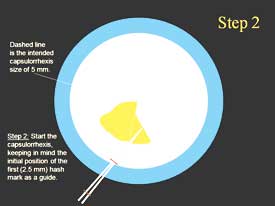 |
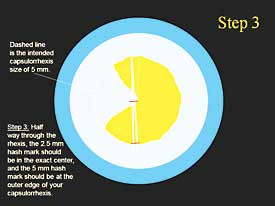 | 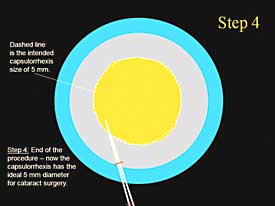 |
Because it is a complete circle, the capsulorrhexis provides a high degree of strength and stability to the capsular bag and keeps the IOL centrally secured. This ensures a consistent postoperative refractive outcome and happy patients.
For more information:
- Uday Devgan, MD, FACS, is in private practice at Devgan Eye Surgery in Los Angeles, Beverly Hills, and Newport Beach, California. Dr. Devgan is Chief of Ophthalmology at Olive View UCLA Medical Center and an Associate Clinical Professor at the Jules Stein Eye Institute at the UCLA School of Medicine. Dr. Devgan can be reached at 11600 Wilshire Blvd., Suite 200, Los Angeles, CA 90025; 800-337-1969; fax: 310-388-3028; e-mail: devgan@gmail.com; Web site: www.DevganEye.com. Dr.Devgan is a consultant to Abbott Medical Optics and Bausch & Lomb, and is a stockholder in Alcon Laboratories and formerly in Advanced Medical Optics.

